Auschwitz February 2006
The month of February 2006 was an extraordinary time for me. I fulfilled two of my ambitions in the short space of two weeks and no one could have picked two more contrasting journeys.
At the beginning of February, I travelled to Detroit to see the Steelers win a Super Bowl and two weeks later I made the pilgrimage to Auschwitz to pay my respects to the victims of the holocaust .
A visit to Auschwitz had been on my mind for a few years. It was a trip that I had been meaning to make, but circumstances never allowed that need to become a reality. Just ten days after an arriving back from my adventure to Detroit with Sheri and Ed, I was travelling to Poland with my friends Pete and Colin.
One voyage took me to the top of the world to see the Lombardi trophy once again returning to Pittsburgh. The other journey took me to the depth of extreme of misery that is a Nazi concentration camp.
The only common factor that I could find between the two journeys was the snow. For a southern softie like me, snow is a big deal. I never see it – unless it’s when I’m in Pittsburgh!
There had always been just one condition (placed by myself) for my visit to Auschwitz. I had only wanted to go when there was snow on the ground, which is why I decided to go in winter.
There are the remnants of two concentration camps in southern Poland, near the city of Oswiecim, Auschwitz and Birkenau, sometimes called Auschwitz I and Auschwitz II.
Hell I and Hell II would be more appropriate names for those camps. For the background to their historic details, please visit the official Auschwitz and Birkenau web site.
Heinrich Himmler, commander of the SS and officer in charge of the concentration camps, visited Auschwitz I in March 1941 and ordered its enlargement to hold 30,000 prisoners. He also ordered the construction of Auschwitz II to hold 100,000 inmates on the site of the village of Brzezinka (Birkenau), roughly 2 miles from the main camp.
This enormous second camp had been intended to be filled with captured Russian POWs who would provide the slave labour to build the SS 'utopia' in Upper Silesia.
Under terrible conditions, which resulted in a terrible loss of life, the extensive construction work began in October 1941. About 10,000 Russian POWs died during the building of the camp. The Birkenau camp eventually became a monument to Teutonic efficiency in making an effortless production line of death.
My friend Pete had travelled to Auschwitz in 1998, so with his knowledge and the internet close to hand, it became easy to plan this visit. Having a new Polish airline, Wizz Air, flying into Katowice helped enormously. In addition, having a good friend Witold Dyozinski from Poland helping me out was a definite bonus.
Witold arranged for guide Pavel to escort us around and organised a taxi driver for us, Bogmir. We knew we would be in goods hands and they proved an invaluable assistance with their local knowledge to help us travel around.
Although Pavel’s English was good, there was always a colloquial barrier between us. We English have some strange sayings, as my friends in Pittsburgh know, so you can imagine what poor Pavel must have been thinking. He also had to deal with my sense of humour, which is not such an easy task.
After a hasty walk around the area, where our Hotel Silesia was situated, we had an interesting meal at our hotel and a nice bottle of wine to wash away the dust of our journey.
The next morning, we set out for Auschwitz at a reasonable time, but the language barrier initially led to some confusion as our visit to the camp began with our arrival at Auschwitz I.
Pavel tried to explain that there was an hour to wait until the guided tour began. We thought he was telling us that we only had an hour in total for our visit. I overcame the confusion in my usual stoic fashion with the attitude that if anyone thought that I had made this journey just to touch the surface of history, please think again.
It makes a lot of sense for visitors to begin their visit at Auschwitz I as the ticket and information offices are located there and it is also where the tours with the official guides begin. The tours start with a 15 minutes film that provides the history of the camps, focussing on the horrors that greeted the liberators who first revealed this tragedy to the unbelieving outside world.
I was grateful that we arrived earlier than the first tour began as it gave us an opportunity to walk around the camp by ourselves. As you leave the visitor’s centre, the first image is the camp gate.
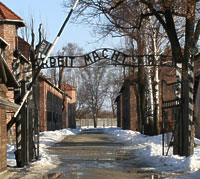 Arbeit Macht Frie is the myth above the camp gate. Gates to Hell would be more a more appropriate confirmation of the heartbreaking truth.
Arbeit Macht Frie is the myth above the camp gate. Gates to Hell would be more a more appropriate confirmation of the heartbreaking truth.
“Work is Liberty. Work Makes You Free. Work will set you free.” I have seen several translations of the Nazi lie that Arbeit Macht Frie betrays.
My translation of those words would simple be, “Abandon hope all ye who enter here.” Dante’s inscription at the entrance to hell is an apt caption for the tragedy that a Nazi concentration camp was during those terrible times.
We went through the gate and took a left to approach Crematorium I, which operated from August 15 1940 to July 1943. The largest room in the building was designed as a morgue.
In the autumn of 1941, it was adapted as the first provisional gas chamber in the camp. With the first killing clouds of Zyklon B, the SS slaughtered thousands of newly arrived Jews as well as several groups of Soviet POWs within the walls.
When you enter the crematorium room, the starkness doesn’t truly represent the unimaginably inferno it was in those dark, tragic days of World War II.
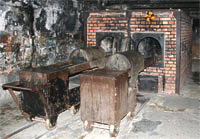 You are faced with two furnaces that don’t look big enough for the continuous horrifying use they were put to. The Germans solved that challenge by building more.
You are faced with two furnaces that don’t look big enough for the continuous horrifying use they were put to. The Germans solved that challenge by building more.
Standing inside. Alone. Staring at the furnaces, reflecting on what had gone before. You can never visualise the true horror of it all.
Who could picture what life had meant for the wretched prisoners cremating the victims of Nazi hatred? It’s hard to image the prisoners having no emotions as they cremated the dead.
If survival meant cremating young children with their mothers, then so be it. You were in an unimaginable world, quite distant from any reality from the real world.
The main priority for any prisoner was to survive. That gave them an abnormal outlook to their tragic lives. Patients in the hospital declared unfit to work were taken to this gas chamber. Poles sentenced to death by the German summary court were shot here and their bodies then burned.
With time moving on, we headed back to the tourist centre to find our guide. The lady who took our tour had lost relatives in the camp and you could feel her emotions as she described the horror of it all. I didn’t always stick with the tour as there were some sights that I didn’t want to see.
The display cabinets in Auschwitz I were something that I couldn’t bring myself to view. The mass of human hair, the glass case full of spectacles and the model of the Birkenau crematorium were too personal for me.
The replica of the rail platform with the tiny model women and children walking towards the gas chambers doesn’t capture the whole story of their death walk. It does provide an insight to the Birkenau that is the second part of the tour.
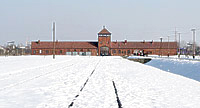 After a short bus journey from the information centre, you arrive at the village of Brzezinka, where most of the Nazi mass extermination took place in Auschwitz II. The victims were delivered to their fate after a horrific ordeal of a train journey, crammed like irrelevant livestock into cattle trucks being delivered to the slaughterhouse.
After a short bus journey from the information centre, you arrive at the village of Brzezinka, where most of the Nazi mass extermination took place in Auschwitz II. The victims were delivered to their fate after a horrific ordeal of a train journey, crammed like irrelevant livestock into cattle trucks being delivered to the slaughterhouse.
As Hitler’s armies waged war on several fronts, the necessity for his servants to exercise his final solution spelt death for the hundreds of thousands of prisoners transported from the Nazi occupied countries of Europe.
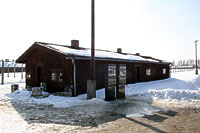 Teutonic efficiency was the key to Hitler’s grandiose idea of a racial purity displayed by the SS officer who stood on the platform with each train’s arrival indicating with a simple gesture of his thumb whether you lived or died.
Teutonic efficiency was the key to Hitler’s grandiose idea of a racial purity displayed by the SS officer who stood on the platform with each train’s arrival indicating with a simple gesture of his thumb whether you lived or died.
He wasn’t just playing God; he probably thought he was as he looked down at the inferior races being herded to their death.
Row upon row of wooden huts with the brick foundations outlining death’s village in the snow.
Our guide took us into one of the woman's huts and that is when it finally hit me.
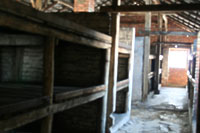 To have an opportunity to reflect on the bare conditions and the bitter cold was sufficient for me to feel distressed. The thought of these poor vulnerable women suffering so terribly while trying to survive this terrible torture was overpowering. How did they manage to cling to life?
To have an opportunity to reflect on the bare conditions and the bitter cold was sufficient for me to feel distressed. The thought of these poor vulnerable women suffering so terribly while trying to survive this terrible torture was overpowering. How did they manage to cling to life?
There is an overpowering feeling of utter despair that it actually happened. This was no showcase for the glories of Nazism; this was a tragic reminder of the depths of evil that the master race fell to.
Trust me, you do feel some of that dreadful pain. The starkness and the cold combine to give you a tiny glimpse of the suffering and horror that engulfed the victims every second of their long, pitiful days of existence. Add to that the daily trauma of a human life being worth nothing, if even that much, and you still don’t get even close to understanding the futility of it all.
How could anyone do this to another human is beyond anyone’s most sadistic imagination. Yet just sixty years ago it happened and continues to happen now in 2007. We are supposed to learn from history, but it has taught us nothing. One chapter closes and is forgotten before fresh pages of misery are written.
I was amazed by the number of young people who were visiting the camps. They appeared to be mostly eastern Europeans so I expect their knowledge of those events would perhaps have been greater than someone of the same age from the UK.
If any good moments can come out of a visit like this, that surely is it. Those terrible events should not be forgotten and it was uplifting to see youngsters making the time to travel to learn about our recent history. Unfortunately, no one can explain why it happened, but that shouldn't stop us from accepting that it did happen.
With the access to the web that we now have, the history of the world at our fingers. It’s all just a click away. But it’s just words. You have to go there yourself to see and attempt to feel it. I’m not suggesting for one minute that a visit will enable you to understand the true scale of the horror and the misery. You could never do that.
KRAKOW
PHOTO INDEX
STEELERSUK

